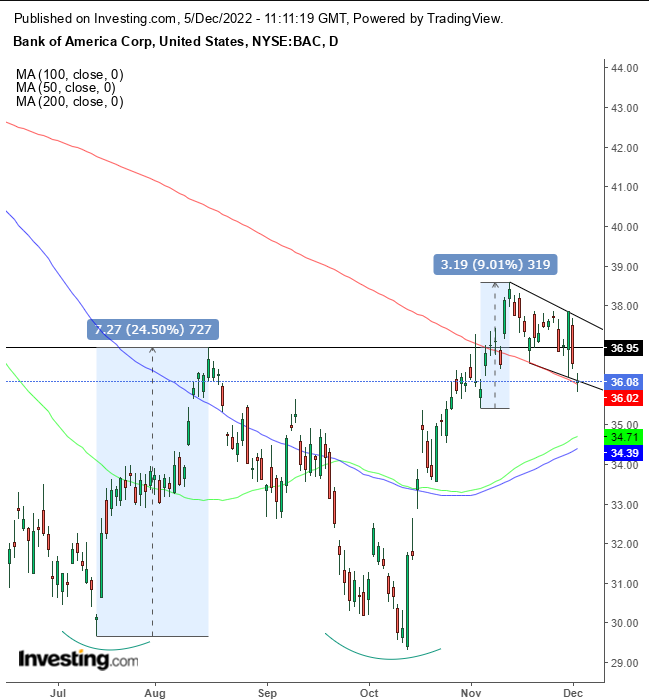Chart of the Day: Is Bank of America Stock Likely to Charge Higher?
2022.12.05 08:40
[ad_1]
The sector dropped 0.5% last week and was the second-worst performing sector after ‘s 1.7% selloff.
Over the last, month the two sectors have maintained a similar relationship. Energy underperformed, rallying just 1.84%, while Financials posted a 6.81% gain. Over the same timeframe, outperformed.
So there is a positive correlation between Financials and Energy and a negative correlation between those two sectors and the Communication Services sector.
Energy and Financials tend to excel when the economy is growing. Demand for energy rises with the rise in travel and manufacturing and Financials benefit from rising interest rates as they boost bank profits. Communication Services is one of the strongest growth sectors as it excels during most of the business cycle.
So does the recent underperformance of Energy and Financials suggest that economic growth has stalled?
The Energy sector has been dented by COVID lockdowns in China. Bank stocks on the other hand should benefit from higher interest rates which have been rising at the fastest rates since the 1980s. And Friday’s release, which was higher than forecast, could push the U.S. Federal Reserve .

XLF weekly
The Financial sector stands on the edge of a knife. The ETF hovers above a deep drop as the price pushes against its new ceiling since topping out. If XLF closes above $37, it will indicate a bottom. The top reached its implied target.
The chart of Bank of America (NYSE:) stock is a similar picture over the medium term. However, bulls may be scratching the ground ahead of another charge.

BAC Daily
The stock has been ranging in a downward bias in the form of a Falling Flag. This pattern is inherently bullish as bulls lock in profits after a 31.7% surge in under a month.
While the price closed below the flag, it closed above the 200 day moving average (DMA), which might be a more reliable gauge for the supply-demand pressure point at the range’s bottom. If the price breaks the range’s topside, it will demonstrate that ongoing demand absorbs all supply available within the congestion and is forced to look higher for more. Statistically, when that happens, the supply and demand balance tilts in favor of demand, catapulting prices higher. If the flag completes, it might also create a double bottom.
Targets
The aggressive interpretation will measure the move from the Oct 13, $29.31 low, to the Nov 11, $38.60 high, a $9.29 upward movement from the breakout point.
A conservative interpretation would measure the flag pole between the Nov 3, $35.41 low to the Nov 11, $38.60 high, a $3.19 upward move from the breakout point. However, the flag’s upside breakout would also complete a double bottom, whose height implies a $7.27 movement from its $36.95 neckline, targeting $44.22.
Trading Strategies – Long Position
Conservative traders should wait for the flag to complete with an upside breakout that remains above the pattern for at least three days, closing above the Nov. 11 high, then wait for a return move that would retest the flag’s support.
Moderate traders would be content with penetrating $38 and two days in which the price remains above the flag, then wait for a dip for a better entry.
Aggressive traders could enter a long now, provided they accept the higher risk which is proportionate to the potentially higher gains of beating the market.
Trade Sample – Aggressive Long
- Entry: $36
- Stop-Loss: $35
- Risk: $1
- Target: $39
- Reward: $3
- Risk-Reward Ratio: 1:3
Disclaimer: At the time of publication, the author had no positions in the securities mentioned.
[ad_2]








